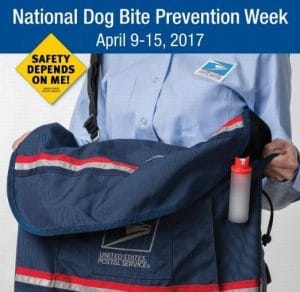 The U.S. Postal Service® continues its tradition of calling attention to one of the nation’s most commonly reported public health problems: dog attacks and bites. From nips and bites to actual attacks, violent dog behavior continues to pose a serious threat to our employees.
The U.S. Postal Service® continues its tradition of calling attention to one of the nation’s most commonly reported public health problems: dog attacks and bites. From nips and bites to actual attacks, violent dog behavior continues to pose a serious threat to our employees.
Previously, National Dog Bite Prevention Week (NDBPW) took place during the third week of May. We are moving it to the second week of April since warmer weather means more dogs outdoors.
This year, NDBPW is Sunday, April 9 through Saturday, April 15. To build momentum for media attention, the national kick-off takes place Thursday, April 6. A news release issued that day on about.usps.com/news/welcome.htm will provide the top 30 city rankings of dog attacks.
To emphasize the enormity of this issue, we are reporting the number of dog attacks and bites as one number. Last year, 6,755 Postal Service™ employees were victimized by dogs, an increase of 206 attacks over calendar year 2015.
Sponsored by the U.S. Postal Service, National Dog Bite Prevention Week is a public service campaign that offers safety tips and emphasizes the need for increased owner responsibility in the prevention of dog attacks.
The tools available in this kit, and additional tools now electronically posted, will guide you in promoting awareness of this public health concern in an effort to reduce dog attacks and bites in your community.
Please take full advantage of our field communications professionals listed in this kit when promoting this initiative.
Dog Bite Prevention Background and Tips
The Victims
- More than 4.5 million people are bitten annually.
- Children are the majority of victims and are 900 times more likely to be bitten than letter carriers.
- The American Veterinary Medical Association (AVMA) and the Centers for Disease Control (CDC) report that small children, the elderly, and letter carriers, in that order, are the most frequent victims. Dog attacks are the most commonly reported childhood public health problem in the United States.
- The AVMA also reports that the number of dog attacks exceeds the reported instances of measles, whooping cough, and mumps, combined. Dog bite victims account for up to 5 percent of emergency room visits.
- Many attacks reported by letter carriers in 2016 came from dogs whose owners used those famous last words, “my dog won’t bite.”
- According to the AVMA, as many as 800,000 people annually are admitted to U.S. emergency departments with dog bite–associated injuries, and countless more bites go unreported and untreated.
How to Avoid Being Bitten
- Don’t run past a dog. The dog’s natural instinct is to chase and catch you.
- If a dog threatens you, don’t scream. Avoid eye contact. Try to remain motionless until the dog leaves, and then back away slowly until the dog is out of sight.
- Don’t approach a strange dog, especially one that’s tethered or confined.
- While letter carriers are discouraged from petting animals, people who choose to pet dogs should always let a dog see and sniff them before petting the animal.
- If you believe a dog is about to attack you, try to place something between yourself and the dog, such as a backpack or a bicycle.
How to Be a Responsible Dog Owner
- Obedience training can teach dogs proper behavior and help owners control their dog in any situation.
- When the letter carrier comes to your home, keep your dog inside, away from the door, in another room, or on a leash.
- Dogs can be protective of their territory and may interpret the actions of letter carriers as a threat. Please take precautions when accepting mail in the presence of your pet.
- Dogs that haven’t been properly socialized, receive little attention or handling, or are left tied-up for long periods of time frequently turn into biters.
